Order-3-7 hexagonal honeycomb
In the geometry of hyperbolic 3-space, the order-3-7 hexagonal honeycomb or (6,3,7 honeycomb) a regular space-filling tessellation (or honeycomb) with Schläfli symbol {6,3,7}.
| Order-3-7 hexagonal honeycomb | |
|---|---|
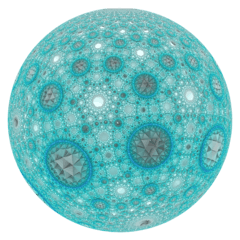 Poincaré disk model | |
| Type | Regular honeycomb |
| Schläfli symbol | {6,3,7} |
| Coxeter diagrams | |
| Cells | {6,3} |
| Faces | {6} |
| Edge figure | {7} |
| Vertex figure | {3,7} |
| Dual | {7,3,6} |
| Coxeter group | [6,3,7] |
| Properties | Regular |
Geometry
All vertices are ultra-ideal (existing beyond the ideal boundary) with seven hexagonal tilings existing around each edge and with an order-7 triangular tiling vertex figure.
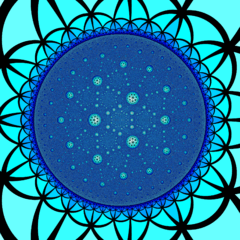 Rendered intersection of honeycomb with the ideal plane in Poincaré half-space model |
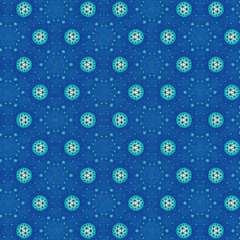 Closeup |
Related polytopes and honeycombs
It a part of a sequence of regular polychora and honeycombs with hexagonal tiling cells.
| {6,3,p} honeycombs | |||||||||||
|---|---|---|---|---|---|---|---|---|---|---|---|
| Space | H3 | ||||||||||
| Form | Paracompact | Noncompact | |||||||||
| Name | {6,3,3} | {6,3,4} | {6,3,5} | {6,3,6} | {6,3,7} | {6,3,8} | ... {6,3,∞} | ||||
| Coxeter |
|||||||||||
| Image | 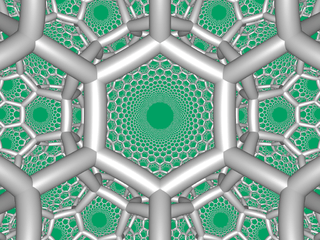 |
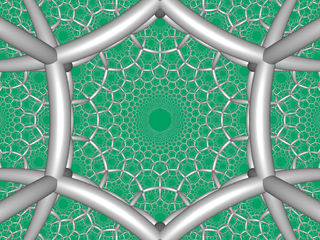 |
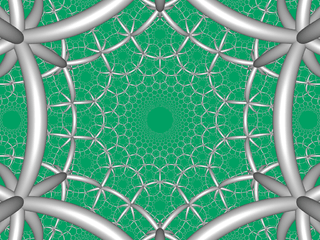 |
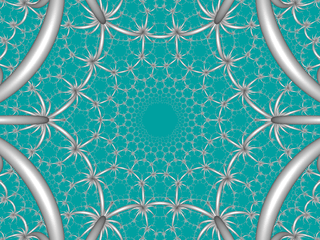 |
 |
 |
 | ||||
| Vertex figure {3,p} |
{3,3} |
{3,4} |
{3,5} |
{3,6} |
{3,7} |
{3,8} |
{3,∞} | ||||
Order-3-8 hexagonal honeycomb
| Order-3-8 hexagonal honeycomb | |
|---|---|
| Type | Regular honeycomb |
| Schläfli symbols | {6,3,8} {6,(3,4,3)} |
| Coxeter diagrams | |
| Cells | {6,3} |
| Faces | {6} |
| Edge figure | {8} |
| Vertex figure | {3,8} {(3,4,3)} |
| Dual | {8,3,6} |
| Coxeter group | [6,3,8] [6,((3,4,3))] |
| Properties | Regular |
In the geometry of hyperbolic 3-space, the order-3-8 hexagonal honeycomb or (6,3,8 honeycomb) is a regular space-filling tessellation (or honeycomb) with Schläfli symbol {6,3,8}. It has eight hexagonal tilings, {6,3}, around each edge. All vertices are ultra-ideal (existing beyond the ideal boundary) with infinitely many hexagonal tilings existing around each vertex in an order-8 triangular tiling vertex arrangement.
 Poincaré disk model |
It has a second construction as a uniform honeycomb, Schläfli symbol {6,(3,4,3)}, Coxeter diagram, ![]()
![]()
![]()
![]()
![]()
![]()
Order-3-infinite hexagonal honeycomb
| Order-3-infinite hexagonal honeycomb | |
|---|---|
| Type | Regular honeycomb |
| Schläfli symbols | {6,3,∞} {6,(3,∞,3)} |
| Coxeter diagrams | |
| Cells | {6,3} |
| Faces | {6} |
| Edge figure | {∞} |
| Vertex figure | {3,∞}, {(3,∞,3)}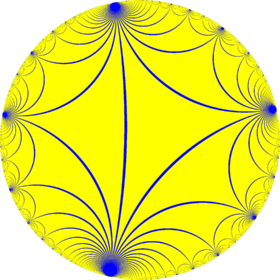  |
| Dual | {∞,3,6} |
| Coxeter group | [6,3,∞] [6,((3,∞,3))] |
| Properties | Regular |
In the geometry of hyperbolic 3-space, the order-3-infinite hexagonal honeycomb or (6,3,∞ honeycomb) is a regular space-filling tessellation (or honeycomb) with Schläfli symbol {6,3,∞}. It has infinitely many hexagonal tiling {6,3} around each edge. All vertices are ultra-ideal (existing beyond the ideal boundary) with infinitely many hexagonal tilings existing around each vertex in an infinite-order triangular tiling vertex arrangement.
 Poincaré disk model |
 Ideal surface |
It has a second construction as a uniform honeycomb, Schläfli symbol {6,(3,∞,3)}, Coxeter diagram, ![]()
![]()
![]()
![]()
![]()
![]()
See also
- Convex uniform honeycombs in hyperbolic space
- List of regular polytopes
- Infinite-order dodecahedral honeycomb
References
- Coxeter, Regular Polytopes, 3rd. ed., Dover Publications, 1973. ISBN 0-486-61480-8. (Tables I and II: Regular polytopes and honeycombs, pp. 294–296)
- The Beauty of Geometry: Twelve Essays (1999), Dover Publications, LCCN 99-35678, ISBN 0-486-40919-8 (Chapter 10, Regular Honeycombs in Hyperbolic Space) Table III
- Jeffrey R. Weeks The Shape of Space, 2nd edition ISBN 0-8247-0709-5 (Chapters 16–17: Geometries on Three-manifolds I,II)
- George Maxwell, Sphere Packings and Hyperbolic Reflection Groups, JOURNAL OF ALGEBRA 79,78-97 (1982)
- Hao Chen, Jean-Philippe Labbé, Lorentzian Coxeter groups and Boyd-Maxwell ball packings, (2013)
- Visualizing Hyperbolic Honeycombs arXiv:1511.02851 Roice Nelson, Henry Segerman (2015)
External links
- John Baez, Visual insights: {7,3,3} Honeycomb (2014/08/01) {7,3,3} Honeycomb Meets Plane at Infinity (2014/08/14)
- Danny Calegari, Kleinian, a tool for visualizing Kleinian groups, Geometry and the Imagination 4 March 2014.